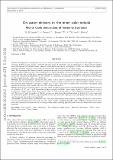Files in this item
Water delivery in the inner solar nebula : Monte Carlo simulations of forsterite hydration
Item metadata
| dc.contributor.author | D'Angelo, Martina | |
| dc.contributor.author | Cazaux, Stephanie | |
| dc.contributor.author | Kamp, Inga | |
| dc.contributor.author | Thi, Wing-Fai | |
| dc.contributor.author | Woitke, Peter | |
| dc.date.accessioned | 2018-11-01T13:30:06Z | |
| dc.date.available | 2018-11-01T13:30:06Z | |
| dc.date.issued | 2019-02-20 | |
| dc.identifier | 256417551 | |
| dc.identifier | 9fee7d83-1da4-42c7-9c7e-e30e3f5e4818 | |
| dc.identifier | 85062107764 | |
| dc.identifier | 000459092600001 | |
| dc.identifier.citation | D'Angelo , M , Cazaux , S , Kamp , I , Thi , W-F & Woitke , P 2019 , ' Water delivery in the inner solar nebula : Monte Carlo simulations of forsterite hydration ' , Astronomy & Astrophysics , vol. 622 , A208 . https://doi.org/10.1051/0004-6361/201833715 | en |
| dc.identifier.issn | 0004-6361 | |
| dc.identifier.other | ArXiv: http://arxiv.org/abs/1808.06183v2 | |
| dc.identifier.uri | https://hdl.handle.net/10023/16371 | |
| dc.description | This work is part of the Dutch Astrochemistry program financed by the Netherlands Organisation for Scientific Research, NWO. | en |
| dc.description.abstract | Context: Endogenous or exogenous, dry or wet, various scenarios have been so far depicted for the origin of water on our Solar Systems rocky bodies. Hydrated silicates found in meteorites and in interplanetary dust particles together with observations of abundant water reservoirs in the habitable zone of protoplanetary disks are evidences that support aqueous alteration of silicate dust grains by water vapor condensation in a nebular setting. Aims: We investigate the thermodynamics (temperature and pressure dependencies) and kinetics (adsorption rates and energies, surface diffusion and cluster formation) of water adsorption on surfaces of forsterite grains, constraining the location in the solar nebula where aqueous alteration of silicates by water vapor adsorption could occur efficiently and lead to the formation of phyllosilicates. We analyze the astrophysical conditions favorable for such hydration mechanism and the implications for water on solid bodies. Methods: The protoplanetary disk model (ProDiMo) code is tuned to simulate the thermochemical disk structure of the early solar nebula at three evolutionary stages. Pressure, temperature and water vapor abundance within 1 au from the protosun were extracted and used as input for a Monte Carlo code to model water associative adsorption using adsorption energies that resemble the forsterite [100] crystal lattice. Results: Hydration of forsterite surfaces by water vapor adsorption could have occurred within the nebula lifetime already at a density of 108 cm3, with increasing surface coverage for higher water vapor densities. Full surface coverage is attained for temperatures lower than 500 K, while for hotter grain surfaces water cluster formation plays a crucial role. Between 0.5 and 10 number of Earth’s oceans can arise from the agglomeration of hydrated 0.1 μm grains into an Earth-sized planet. However, if grain growth occurs dry and water vapor processes the grains afterwards, this value can decrease by two orders of magnitude. Conclusions: This work shows that water cluster formation enhances the water surface coverage and enables a stable water layer to form at high temperature and low water vapor density conditions. Finally, surface diffusion of physisorbed water molecules shortens the timescale for reaching steady state, enabling phyllosilicate formation within the solar nebula timescale. | |
| dc.format.extent | 13 | |
| dc.format.extent | 2513472 | |
| dc.language.iso | eng | |
| dc.relation.ispartof | Astronomy & Astrophysics | en |
| dc.subject | Solar nebula | en |
| dc.subject | Water absorption | en |
| dc.subject | Protoplanetary disks model | en |
| dc.subject | Meteorites hydration | en |
| dc.subject | Water cluster | en |
| dc.subject | Monte Carlo code | en |
| dc.subject | Earth's water | en |
| dc.subject | QB Astronomy | en |
| dc.subject | QC Physics | en |
| dc.subject | T-NDAS | en |
| dc.subject.lcc | QB | en |
| dc.subject.lcc | QC | en |
| dc.title | Water delivery in the inner solar nebula : Monte Carlo simulations of forsterite hydration | en |
| dc.type | Journal article | en |
| dc.contributor.institution | University of St Andrews. School of Physics and Astronomy | en |
| dc.contributor.institution | University of St Andrews. St Andrews Centre for Exoplanet Science | en |
| dc.identifier.doi | 10.1051/0004-6361/201833715 | |
| dc.description.status | Peer reviewed | en |
This item appears in the following Collection(s)
Items in the St Andrews Research Repository are protected by copyright, with all rights reserved, unless otherwise indicated.

